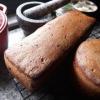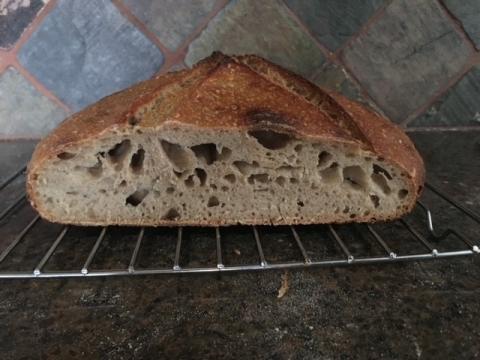
Overnight Heirloom Red

Trying different grains now that I have the Mockmill 200, and this week, I experimented with Turkey Red and Red Fife. Recipe was my standard overnight sourdough recipe with equal parts of Turkey Red and Red Fife as the whole grain component. The grains were milled to pass through a #40 sieve. Result was about 95% extraction. The bran collected was then scalded and used in the final mix. Real happy with how they turned out externally. Nice blisters and bloom. On one of the doughs, I tried using a modified version of Danni's shaping method to use with an oval banneton, and I think it has potential! No idea if I can repeat it, but I'm happy with how the first one turned out. :-)
Crumb shot tomorrow after it's sat for 24 hours.
Makes one loaf...
Final Dough
225g All-Purpose Flour (KA) - 50%
135g Bread Flour (KA) - 30%
36g Turkey Red (Janie's Mill) - 8%
36g Red Fife (Janie's Mill) - 8%
18g Barley Flour (Food to Live) - 4%
68g Raisin Yeast Water - 15%
248g Water - 55%
9g Himalayan Pink Salt - 2%
18g Mature Starter Culture - 4%
1) Mix: Combine all ingredients and mix until flour is wetted. Place in covered bowl.
2) Saltolyse: 60 minutes to hydrate whole grains
3) Moderate Gluten Development: 2 x 50 FF with 5 minute rest between sets
4) Bulk Fermentation: 76 deg F, Coil folds every 60 minutes until dough starts to get puffy (8-9 hours). Continue bulk until dough has expanded 75-80%.
5) Preshape: Shape into a boule. Tighten the boule as needed to assure dough has some structure.
6) Bench Rest: 15-20 minutes
7) Final Shape: Boule or Oval
8) Final Proof: 76-77 deg F until the dome of the dough is slightly above the top of the banneton. (It's hard for me to convey a good end point to others. I go by visual expansion (50-75%) and the dough being "jiggly"). Usually takes 1.5-2 hours.
9) Cold Retard: Refrigerate overnight
10) Bake: Pre-heat oven at 460 deg F for 45 minutes with baking steel in place and oven vent plugged; turn out dough on parchment, mist dough surface, and score; place dough on baking steel and pour 3/4 cup boiling water in steam tray; bake 450 deg F (10 minutes), 425 deg F (10 minutes); vent oven; 425 deg F (10-15 minutes).


























